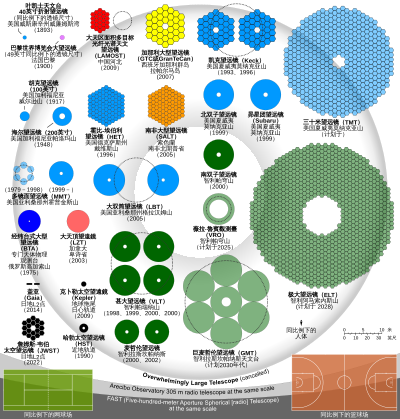双子星天文台
| 双子天文台(Gemini Observatory) | |||||||||
|---|---|---|---|---|---|---|---|---|---|
  在夏威夷的双子北(左图)和在智利的双子南(右图) | |||||||||
| 组织 | 双子财团法人(美国NSF、[加拿大]]NRC、智利CONICYT、巴西MCTI、阿根廷MCTIP)和AURA | ||||||||
| 位置 | 美国夏威夷莫纳克亚山路 智利Cerro Pachón | ||||||||
| 座标 | 19°49′26″N 155°28′11″W / 19.82396°N 155.46984°W 30°14′27″S 70°44′12″W / 30.24073°S 70.73659°W | ||||||||
| 海拔 | 4,213米(13,822英尺) 2,722米(8,930英尺) | ||||||||
| 设立 | 2000 | ||||||||
| 网址 | www | ||||||||
| 望远镜 | |||||||||
| |||||||||
[编辑维基数据] | |||||||||
双子星天文台(英语:Gemini Observatory,又译双子座望远镜)是由美国、英国、加拿大、智利、巴西、阿根廷和澳大利亚等国共同建造的两台位于不同地点、完全相同的望远镜,口径为8.1米。其中一台位于北半球的夏威夷,称为北双子望远镜,另一台位于智利海拔2950米的帕穹山,称为南双子望远镜。
北双子望远镜也称为Frederick C. Gillett望远镜,位于美国夏威夷的莫纳克亚山山顶,海拔4200米,于1999年6月建造完成,2000年投入使用,控制中心位于夏威夷大学在希罗(Hilo)的校园内。
南双子望远镜位于智利的帕穹山,海拔2950米,于2000年开始使用,控制中心位于智利拉希雷纳(La Serena)的托洛洛山美洲际天文台内。
两架望远镜分别位于南北两个半球,可以完全覆盖整个天区。双子望远镜主镜的厚度为20厘米,表面镀了在红外波段具有良好反射能力的银,观测室的内表面涂了铝反射层,目的是获得稳定的热环境。望远镜还安装了主动光学、自适应光学、激光导星系统,整个计划耗资为1.84亿美元,其中美国投资50%,英国25%,加拿大15%,智利5%,阿根廷和巴西各占2.5%,并根据所占份额向各国分配望远镜的观测时间。具体管理工作由大学天文研究协会(AURA)负责实施。
外部链接

| |||||||||||||||||
| ||||||||||||
Text is available under the CC BY-SA 4.0 license; additional terms may apply.
Images, videos and audio are available under their respective licenses.
